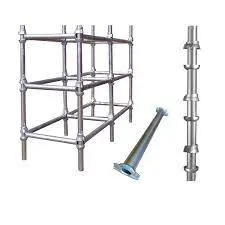Ağu . 09, 2024 21:50 Back to list
Innovative Solutions for Suspended Slab Formwork Manufacturing to Enhance Construction Efficiency and Safety
The Importance of Suspended Slab Formwork in Construction
In the ever-evolving construction industry, the method of erecting structures is crucial for ensuring safety, efficiency, and durability. One of the essential components in modern building techniques is the suspended slab formwork, which plays a vital role in shaping concrete structures. This article delves into the significance of suspended slab formwork, its benefits, and the role of factories in producing high-quality formwork systems.
What is Suspended Slab Formwork?
Suspended slab formwork is a temporary structure used to support wet concrete during the curing process. It allows builders to create large slabs that are not directly supported by the ground, often seen in multi-story buildings and bridges. The formwork helps maintain the shape of the concrete until it hardens, providing a crucial support system that enables the construction of complex architectural designs.
Advantages of Using Suspended Slab Formwork
One of the primary benefits of suspended slab formwork is its ability to provide excellent load-bearing capabilities. It is designed to withstand the weight of wet concrete, construction load, and any additional live loads that may occur during the building process. This strength ensures that the structure remains stable and safe while the concrete cures.
Additionally, suspended slab formwork enhances construction efficiency. Factories specializing in formwork production can create modular systems that are quick to assemble and disassemble, significantly reducing the time required for installation. This efficiency is particularly important in today’s fast-paced construction environment, where project timelines are often tight.
suspended slab formwork factory

Moreover, suspended slab formwork is versatile and adaptable. It can be customized to fit the specific requirements of a project, allowing for a wide range of designs and structural configurations. Factories can produce various types of formwork, including traditional wood forms, steel frames, and advanced plastic or composite materials, catering to different construction needs and budgets.
Sustainability and Innovation
As the construction industry moves toward more sustainable practices, the need for eco-friendly materials and methods has become paramount. Formwork factories are now focusing on the development of reusable and recyclable formwork systems. By producing designs that can be used multiple times, these factories help reduce waste and lower the environmental impact of construction activities.
In addition, technological advancements have led to the introduction of innovative formwork solutions, such as self-climbing formwork systems and digital formwork technologies. These modern approaches enhance the speed and accuracy of construction, making suspended slab formwork even more efficient.
Conclusion
The role of suspended slab formwork in construction cannot be overstated. It is a foundational component that not only supports the physical structure but also contributes to the overall efficiency and sustainability of building projects. As factories continue to innovate and refine their production processes, the quality and range of suspended slab formwork will only improve, allowing for safer, faster, and more sustainable construction practices.
In conclusion, the importance of suspended slab formwork in modern construction remains significant. By understanding its benefits and advancements, stakeholders in the construction industry can better appreciate how this essential component contributes to the successful realization of complex building projects. With ongoing innovations and an increasing focus on sustainability, the future of suspended slab formwork looks promising, paving the way for smarter and more efficient construction practices.
-
Ringlock Scaffolding: Strong, Safe & Efficient Solutions
NewsAug.27,2025
-
OEM Column Formwork: Circular, Curved & Inclined Solutions
NewsAug.26,2025
-
Premium Scaffolding Jacks: Stable, Adjustable & Durable
NewsAug.25,2025
-
OEM Wall Formwork & Shuttering: Flexible & Curved Solutions
NewsAug.24,2025
-
Adjustable Heavy Duty Props for Slab Formwork | Strong & Reliable Support
NewsAug.23,2025
-
Adjustable Heavy Duty Props for Slab Formwork - Strong & Safe Support
NewsAug.22,2025